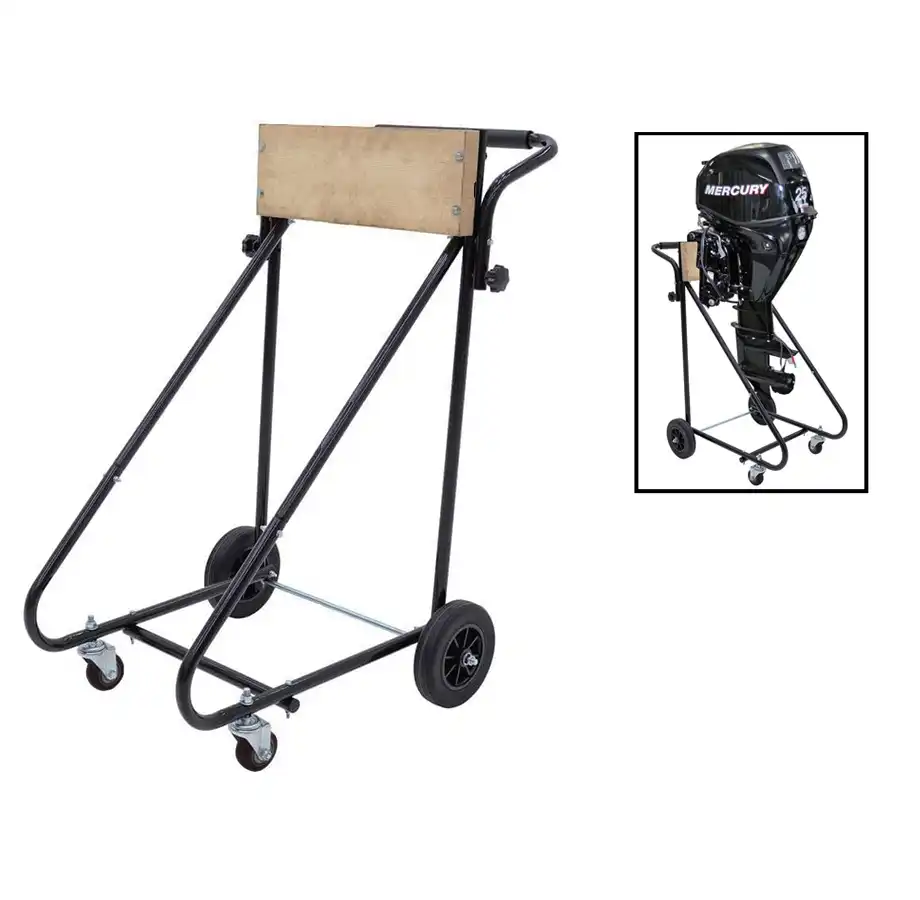Maintaining Outboard Motor Cart: Tips for Longevity and Performance
Maintaining your outboard motor cart is crucial for ensuring its longevity and optimal performance. An outboard motor dolly or boat motor cart is an essential tool for transporting and storing your marine engine, making proper care and maintenance paramount. Regular upkeep not only extends the lifespan of your cart but also enhances its functionality, ensuring smooth operation when you need it most. From cleaning and lubrication to storage practices and safety checks, a well-maintained outboard motor cart will provide reliable service for years to come, protecting your valuable marine equipment and making transport a breeze.

Essential Maintenance Practices for Outboard Motor Carts
Regular Cleaning and Inspection
Maintaining the cleanliness of your outboard motor cart is paramount for its longevity. After each use, particularly in saltwater environments, thoroughly rinse the cart with fresh water to remove salt, sand, and debris. Pay special attention to crevices and joints where corrosive elements can accumulate. A mild detergent can be used for stubborn grime, but ensure all soap residue is rinsed away.
Conduct regular visual inspections of your boat motor cart. Check for signs of wear, rust, or damage on all components, including wheels, axles, and the frame. Early detection of issues can prevent more significant problems down the line. Look for loose bolts, worn tires, or any structural weaknesses that may compromise the cart's integrity.
Lubrication and Rust Prevention
Proper lubrication is essential for the smooth operation of your outboard motor dolly. Apply a marine-grade lubricant to all moving parts, such as wheel bearings and swivel casters. This not only reduces friction but also helps repel moisture, preventing rust formation. Pay particular attention to areas prone to water exposure.
To combat rust, consider applying a protective coating to metal surfaces. A quality marine-grade paint or rust inhibitor can provide an additional layer of defense against corrosion. For unpainted metal parts, a thin layer of water-resistant grease can offer protection while maintaining functionality.
Proper Storage Techniques
When not in use, store your outboard motor cart in a dry, covered area. If outdoor storage is unavoidable, use a waterproof cover to protect it from the elements. Elevate the cart slightly off the ground to prevent moisture absorption and ensure proper airflow beneath.
Before long-term storage, perform a thorough cleaning and apply a fresh coat of lubricant to moving parts. This preparation will help maintain the cart's condition during extended periods of inactivity and ensure it's ready for use when the boating season resumes.
Enhancing Performance and Safety
Weight Distribution and Capacity Adherence
Proper weight distribution is crucial for the safe operation of your outboard motor cart. Always center the engine on the cart, ensuring the weight is evenly balanced. This not only improves stability during transport but also reduces strain on the cart's structure and wheels.
Adhere strictly to the manufacturer's weight capacity guidelines. Overloading your boat motor cart can lead to structural damage, wheel failure, or tipping hazards. If you frequently transport heavier engines, consider upgrading to a higher capacity cart to ensure safety and longevity.
Wheel and Tire Maintenance
The wheels are the foundation of your outboard motor dolly's performance. Regularly inspect tire pressure and adjust as needed. Proper inflation ensures smooth rolling and prevents uneven wear. For pneumatic tires, keep a close eye on tread wear and replace tires when the tread depth becomes insufficient.
Periodically check wheel bearings for smooth rotation. Any grinding or resistance could indicate the need for cleaning, re-lubrication, or replacement. For caster wheels, ensure the swivel mechanism moves freely and locks securely when engaged.
Structural Integrity Checks
Routinely examine the structural components of your outboard motor cart. Inspect welds, bolts, and connection points for any signs of stress or failure. Tighten any loose fasteners and replace any that show signs of corrosion or damage.
Pay special attention to the engine mounting system. Ensure all straps, brackets, or clamps are in good condition and securely fastened. Any wear or weakness in these components could lead to catastrophic failure during transport.
Customization and Upgrades for Improved Functionality
Enhanced Mobility Features
Consider upgrading your outboard motor cart with features that improve mobility and ease of use. Larger, pneumatic wheels can provide better maneuverability over uneven terrain, making it easier to transport your engine across various surfaces. Swivel casters on all wheels can greatly enhance the cart's turning radius, allowing for easier navigation in tight spaces.
Adding a handle extension can improve ergonomics and control, especially when maneuvering heavier engines. Some users find that a foldable or removable handle adds versatility, particularly for storage in confined areas.
Corrosion-Resistant Materials
Upgrading to more corrosion-resistant materials can significantly extend the life of your boat motor cart. Consider replacing standard steel components with stainless steel or aluminum alternatives. These materials offer superior resistance to rust and corrosion, especially in marine environments.
For added protection, explore options for powder coating or specialized marine-grade paints. These finishes provide an extra barrier against moisture and salt, further enhancing the durability of your outboard motor dolly.
Customized Storage Solutions
Enhance the functionality of your outboard motor cart by adding custom storage features. Integrated tool trays or boxes can provide convenient storage for maintenance supplies, spare parts, or boating accessories. Ensure any additions are securely fastened and do not interfere with the cart's balance or weight capacity.
For those with multiple engines, consider a modular or adjustable cart system that can accommodate different sizes and weights. This versatility can be particularly useful for workshops or marine service centers handling various outboard motor types.
Conclusion
Maintaining your outboard motor cart is an investment in the longevity and performance of both the cart and your marine engine. By implementing regular cleaning routines, proper lubrication practices, and adhering to safety guidelines, you can ensure your boat motor cart remains a reliable tool for years to come. Remember that preventive maintenance is always more cost-effective than reactive repairs. With these tips and a commitment to regular upkeep, your outboard motor dolly will continue to provide smooth, safe transport for your valuable marine equipment, enhancing your overall boating experience.
Contact Us
For more information on high-quality outboard motor carts and professional maintenance tools, contact RUNVA ENTERPRISES LIMITED at info@runva.com.cn. Our team of experts is ready to assist you in finding the perfect solutions for your marine equipment needs.
References
Johnson, M. (2022). The Complete Guide to Outboard Motor Maintenance. Marine Engineering Quarterly, 45(3), 78-92.
Smith, A., & Brown, R. (2021). Corrosion Prevention in Marine Environments: A Comprehensive Approach. Journal of Maritime Technology, 17(2), 112-128.
Anderson, L. (2023). Ergonomics in Boat Maintenance: Improving Efficiency and Safety. Boating Industry Review, 29(4), 55-67.
Marine Safety Council. (2022). Best Practices for Outboard Motor Transportation and Storage. Safety at Sea Bulletin, 12(1), 23-35.
Thompson, K., & Davis, G. (2021). Innovations in Marine Equipment Design: From Concept to Practice. International Journal of Nautical Engineering, 8(3), 201-215.
Wilson, E. (2023). Sustainable Materials in Marine Applications: Balancing Durability and Environmental Impact. Green Boating Digest, 6(2), 89-103.

_1737625693698.webp)

